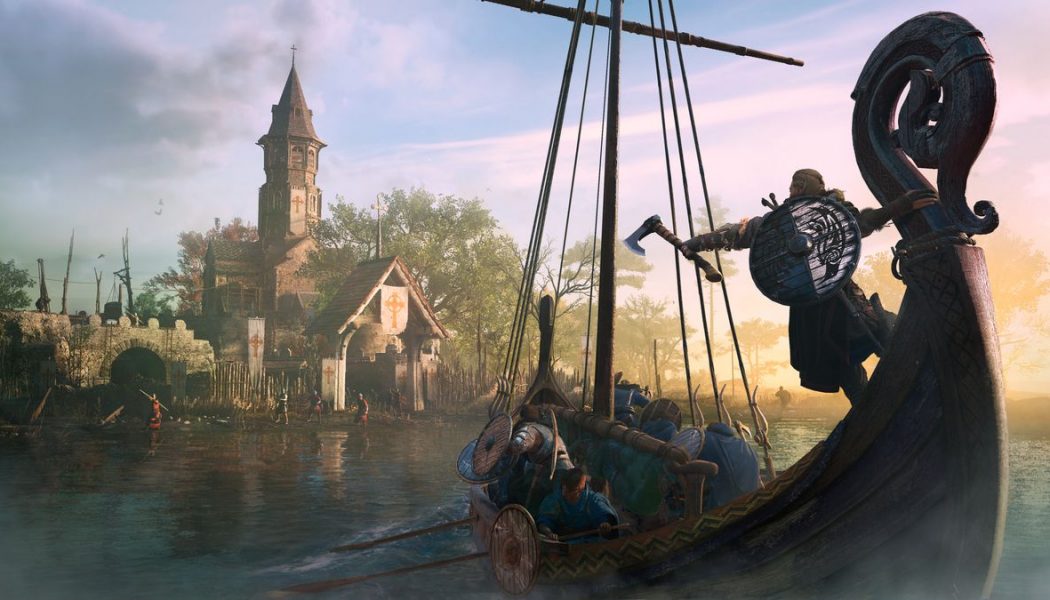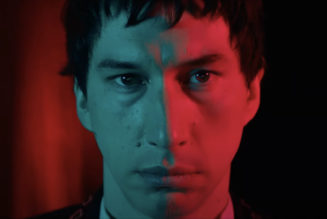It’s been nearly two years, but Ubisoft is finally gearing up to release a new Assassin’s Creed game. Assassin’s Creed Valhalla is billed as “the ultimate viking fantasy,” set not in the fjords of Scandinavia but in the fields and rivers of England during the ninth century Viking invasion. Players are put in the role of Eivor, a Viking from Norway, as they attempt to lead their people to establish a settlement in England.
It may have new Norse trappings and some refreshed gameplay modes and features, but after spending three hours running around Valhalla’s open world, it feels a lot more like an iteration of 2018’s Assassin’s Creed Odyssey than a drastically different experience.
I was able to try out an early version of Valhalla, playing both a chunk of the game’s story and exploring the open world. The demo I played was streamed over Parsec, as the ongoing pandemic made a normal in-person hands-on impossible. Despite those limitations, Valhalla looks absolutely gorgeous; while Odyssey had already set a high bar in bringing Ancient Greece to life, Valhalla’s recreation of England might be the best the series has ever looked, with rolling fields, misty forests, and gorgeous sunsets.
If you’ve played either Origins or Odyssey — the preceding two “modern” Assassin’s Creed titles — then much of Valhalla will be familiar, despite the new map. The weapon, gear, and skill tree system introduced in Origins makes a return in Valhalla, continuing the customization and RPG trends that the series has been following for the past few years, albeit with a few new wrinkles. Instead of the hunter (bows), warrior (melee), and assassin skill trees, Valhalla has “wolf,” “bear,” and “raven” trees that correspond loosely to those categories, although they’re less strictly defined in previous games.
Different weapons and armor sets also synergize with those categories, so “raven” armor sets will get a boost if you’ve invested heavily in stealth-based skills, while a pair of wolf axes will get a bonus if you focused more on the corresponding skills.
:no_upscale()/cdn.vox-cdn.com/uploads/chorus_asset/file/20077547/ACV_UbiFwd_0720_OpenWorld_Two_Female.jpg)
Valhalla is also less obviously focused on being an RPG — for example, there’s less emphasis on damage indicators for weapons or percentile perks for items (although every blow does still have a damage number pop-up overhead). More importantly, there’s also no leveling system anymore. Instead, players have a “global power” level that’s based on the number of skills they’ve unlocked. The skill tree also has a lot more nodes to unlock, with more incremental upgrades like increases to melee or ranged attacks intermixed with larger new skills, to allow for a more customizable and continual rate of progression than tying all new abilities to leveling up.
Combat is also virtually identical to previous AC titles. Players have the choice of heavier, two-handed weapons as well as quicker single-hand axes and flails, and the added option to dual-wield smaller weapons (I quickly embraced a pair of axes that felt fitting to the setting). Like in previous games, there’s a big emphasis on mixing up your light and heavy attacks with parries and blocks to dispatch your enemies.
Odyssey’s special abilities system — bound to the face buttons when holding down the left trigger (for ranged weapons) or right trigger (for melee) — is also back. Old favorites like the Spartan Kick or Multi-shot have returned for Valhalla (albeit with new, Norse-inspired names), although there are some new options, too, like the incredibly satisfying rapid-fire throwing axes.
:no_upscale()/cdn.vox-cdn.com/uploads/chorus_asset/file/20077555/ACV_UbiFwd_0720_Story_Serious_Male.jpg)
Also virtually identical to the previous two games is the exploration loop out in the open world. Some series mainstays will never leave: there’s still the “go to the top of the building / pillar / tall object” to “synchronize” and reveal points of interest in the surrounding map before diving into an impossibly soft bale of hay. The compass wheel from Origins is still present, gently guiding players toward new objectives, as is your bird companion (this time, a raven named Sýnin), which players can use to scout out new areas and mark enemies.
Players also have a Viking longship, which can be used to navigate the streams of England, complete with the now-requisite Assassin’s Creed boat shanties, and a second option for God of War-style recounting of epic tales and battles while you travel. Unlike previous games, though, the longship is mostly meant for traversal — and bringing your crew to raid settlements to gain resources for your own base.
Like Odyssey, Valhalla offers interactive dialogue that lets players make key choices about how they progress, like whether to kill a rival leader, recruit an ally, or romance a companion. (And also like in Odyssey, all romanceable characters are available partners for both the male and female versions of Eivor.) In an interesting improvement, not only can players choose between male and female versions of the main character, Eivor, at the start of the game, they can also freely switch between genders at any point in gameplay.
Even with all those core elements largely the same, there are some new and interesting features in Valhalla. The game takes a few steps back toward the franchise’s roots, with the return of the classic hidden blade for assassinations. And unlike Odyssey, players have the ability to insta-kill nearly any enemy — including some bosses — with a single blow, although there’s an extra timing element to successfully accomplish the task that I wasn’t able to nail down in my attempts.
One of the more interesting changes in Valhalla is the scale of some battles. While previous Assassin’s Creed games have focused on the idea of the player as a one-man smaller army, Valhalla is emphasizing larger battles with NPC companions. “Raids” are a key new element here; I was able to unleash my longship full of viking warriors against a fortified church or base, fighting side by side with my crew against a battalion of soldiers (who you’ll have to keep an eye on and revive as necessary). Raids aren’t required: stealthy players can still infiltrate, parkour, and stab their way through their goals. But they’re an interesting new option.
:no_upscale()/cdn.vox-cdn.com/uploads/chorus_asset/file/20077557/ACV_UbiFwd_0720_Gameplay_Assault.jpg)
A longer “Assault” level built on that concept in a story mission. There, I led a full-scale invasion of a castle, dodging sheets of flaming arrows from the defenders as I led a fleet of longboats, before fighting my way through successive gates that had to each be breached by a battering ram (which is able to be controlled by your troops, with your direction). The whole mission culminated in a final boss fight against a rival Viking leader, who I could have optionally assassinated by sneaking around the back of the castle.
There are also some smaller changes. The health system has been revamped in Valhalla: passive regeneration while out of combat was replaced by a set number of “rations” that allow players to restore a chunk of their life bar at will. Those rations get replenished by harvesting the plentiful edible items (like berries or mushrooms) around the game world, but it adds an additional dimension to combat by giving players a new system to manage. In the practical sense, giving players access to more health means combat encounters can be longer and enemies more deadly.
Valhalla also features overt in-game reminders toward the present-day frame narrative (where players are technically playing as the series’s modern-day protagonist Layla Hassan, who is experiencing these memories of the past using a machine called an “Animus”). In Valhalla, players can now encounter an intentionally glitched-out area where frames will stutter and objects will blink in and out of existence, where you can activate an “Animus Anomaly” challenge. It’s effectively a slightly more difficult parkour run that puts players in charge of Hassan (instead of Eivor) and offers more information on the present-date plot.
There’s also a variety of other puzzles and mini-games scattered around the massive world, including world bosses, legendary animals, and elite “Drengr” warriors for players looking for even tougher combat challenges. Viking drinking contests and “flyting” insult battle mini-games let you test rhythm skills. There’s even a new fishing mode.
Obviously, Valhalla promises to be a massive game, and it’s hard to make any real judgements from the comparatively brief snippet I played. (One of Valhalla’s biggest new features — a customizable Viking settlement that also serves as the main customization hub for Eivor — wasn’t available in this demo to test out.)
But at its core, Valhalla feels extremely similar to the titles that came before it, which isn’t a bad thing: both Odyssey and Origins were fresh and deeper takes on the classic Assassin’s Creed style. If what you’re looking for is more of that, then Valhalla will absolutely provide.









